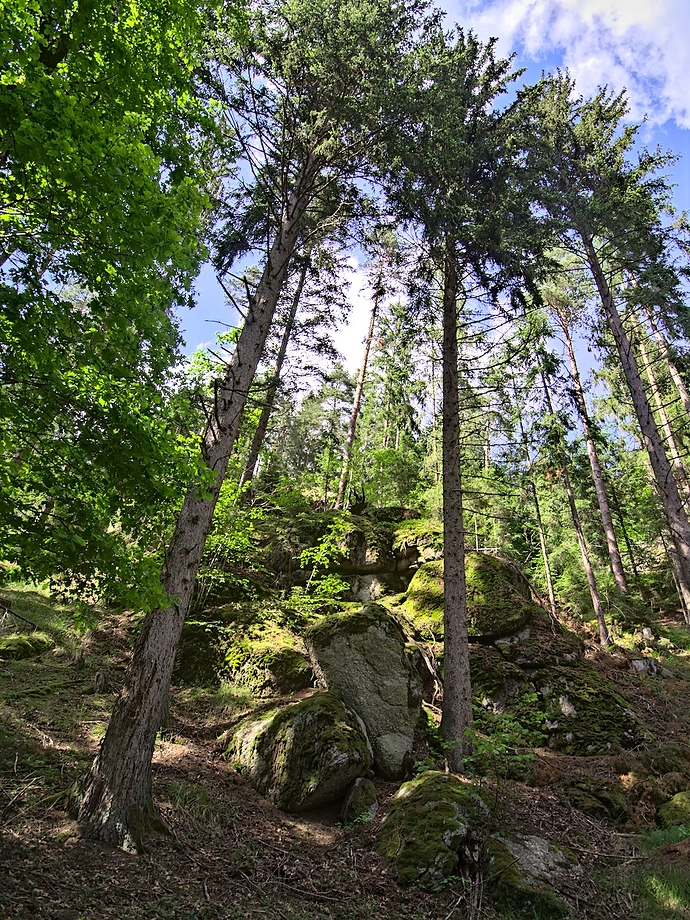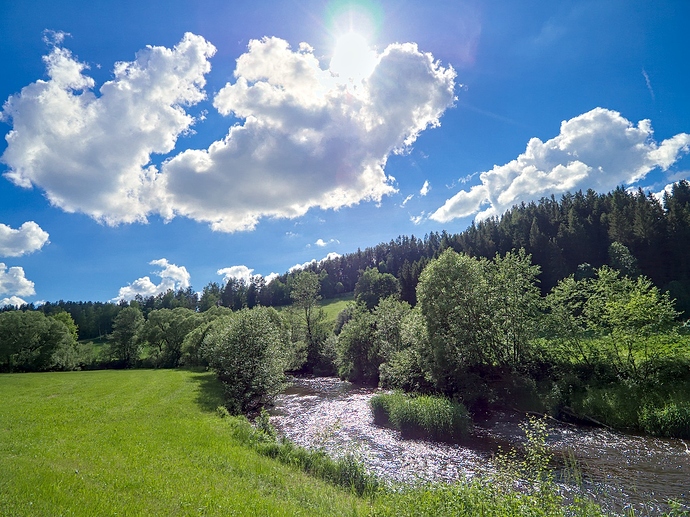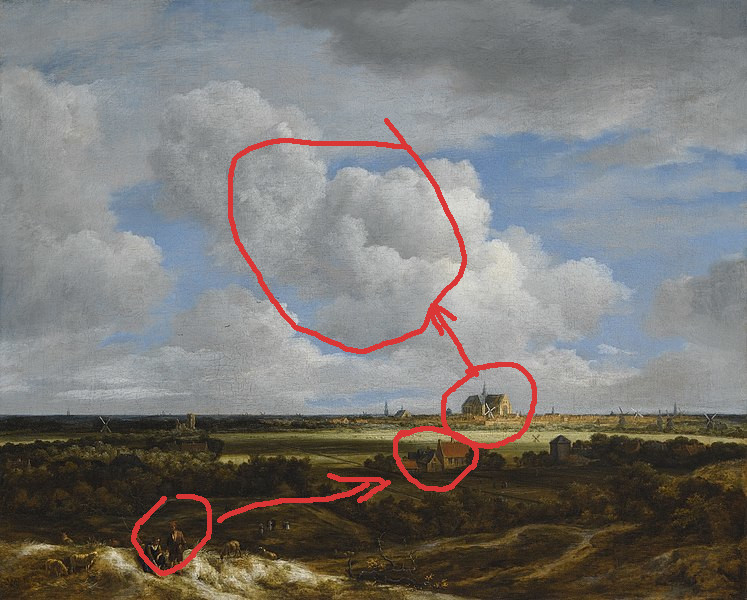I find cumulus clouds to be fine subjects for monochrome treatment. Especially if you dial the red channel up, makes them pop from the sky…
What do you mean? You mean it’s slow?
Oh so slow… The bayous of southern Louisiana look like brown mirrors, makes you wonder how many decades it takes for that water to make it to the sea…
Growing up, I yeared to see the burbling brooks and raging rivers of the mountains. The most gorgeous river I’ve ever seen, hands down, was the Rogue River in the Cascade Mountains west of Bend, OR, USA.
I use babbling but burbling works too. A gentle brook is better than a roaring river, which may take away your babbling burbling. ![]() Oh, there goes my prized camera…
Oh, there goes my prized camera…
@Soupy mentioned the need for a “hero tree”, but here the “hero tractor” does just fine.
Very nice! This one is like a Corot landscape.
Your latest are more interesting.  These landscapes are well kept.
These landscapes are well kept. 
I’ve chosen this one to reply to, but it is one of a few that I really like.
Maybe I’m just now starting to pay real attention to your shots/edits but I do get the impression that I see progress here and something you could call a persona; style(?).
Anyway: I’m enjoying your posts, keep them coming!
@afre @Jade_NL @Soupy @Ofnuts @ggbutcher Thanks for the great feedback, guys!
Do you mean you see a stylistic development? I think that’s really interesting. You know I do have a PhD in art history but self-analysis is not easy, seeing the own works from outside is almost impossible. Well it is possible but only form a temporal distance.
To be honest, I am realtively new to landscape photography, I think I started in August 2018. I do hope that I am learning. Probably I am still a bit searching for my landscape style. In my experience, you are starting to be really advanced in image editing when you start to change your opinion about your own edits. It is always possible to improve something, a photo is never perfect. At the moment one of my biggest problems is that I am never satisfied with my own edits I guess.
So I am curious, maybe you could analyze or describe my style? What kind of effect do my photos have on you (apart form like or not like)? Do they make you feel something?
Indeed I do think that my landscape style is different form my “butterflies-and-squirrels” style. I wanted to change my style for a long time… Of course, there are always things in a human personality that cannot change but… anyway I hope this will be an interesting discussion…
And, well… it is important to be aware that an edit is an interpretation and that there are many good interpretations and possibilities.
So I’d be happy if you (I am addressing everybody here) could try to be more analytic. I think Jade_NL is on an interesting path…
I don’t have much critique about your post processing, its actually quite consistent. For me, a lot of the compositions lack a major focal point. Emulating paintings is tough, as painters have the opposite struggle of photographers. Painters include, photographers exclude.
Beautlful scenery doesn’t necessarily translate to great photographs. I’d also pay more attention to the lighting. Go later or earlier in the day for a bit more drama. It’ll also be easier to not clip your highlights in the sky if you’re closer to sunrise or sunset.
First: You know analysis is not the same thing as cirtique. But it’s no problem.
Second: I know about that light thing. The problem is, I have no car, not even a drivers license, and the places that I am visiting are not easy to reach with public transport. Mostly there is one bus in the morning and one in the evening and a lot of walking inbetween. The alternative would be staying one or two nights at the village, but I am not sure I am willing to invest that money as I am not making any money with photography.
Third: I think I don’t understand that focal point thing, although I have heared something very similar from someone else before. But I think it’s possible that you don’t understand something eseential about my photos. Example: The person who said this a few days ago said that in one of my photographs which happes to show a little bridge in an alpine landscape the bridge should be the focal point. But she clearly misunderstood everything because I’d prefer the landscape without the bridge, I just couldn’t make it disappear so somehow I had to deal with it, but it’s definitely not the focal point for me. In some other photos… there is maybe something like a “conflict” or imbalance between earth and sky, I admit that, I think it’s really not an easy task, but I don’t know if that’s what you mean. Anyway you should explain that focal point thing better.
Btw, I don’t agree at all that photographers do the opposite of painters but I think it’s an interesting question. In many respects, photography is the direct continuation of painting.
Edit: Actually, at the places that I visit often there is not even a hotel or something like that.
Its a shame the logistics don’t work for you because I agree light in the early morning and late afternoon make for nicer photographs. Some people see photography as being more about light and colour than about subjects, that’s how big an effect it has.
On the matter of focal point I understand what paperdigits is saying, but I think its because in many of Anna’s images the focal point is not where we traditionally look - her focal point is the sky and clouds, moreso than the landscape. The images make you look up. Therefore the feel is airy, open, distant. Like the world is just a little unimportant place beneath the greater expanse of heaven. And without strong focal points, the landscapes, and thus the world, seem unorganised, sprawling. Because the landscapes are beautiful and lush it seems peaceful, healthy and harmonious. Many of her recent photographs frame more for the trees and thus have clearer focal points, but even then there is the tendency towards the sky.
It would be interesting to see a sidecar from your processing, because when viewed full, often the detail doesn’t look sharp. But I’m not sure blur is the right description either. Blotchy, perhaps? Coarse. A bit like what my camera does in low light at high ISO with noise reduction. But given these are bright daylight shots, I’d be surprised if that was happening. Were these images heavily compressed before upload?
i began to analyze, but didn’t feel that the component parts of your images held up to analysis, thus the critique. You also said you were new to landscape photography, but clearly not to the study of landscapes. Translating your knowledge of the great paints into your own works is tricky indeed; not an easy under taking.
That’s a bit of an understatement ![]()
Fair enough.
I think it is your job as the artist to communicate to me via your work.
I think the problem in about half of your images is that you’re not pushing my eye is any specific direction. I want something to pull me into the photograph. Consider the following…what am I I supposed to look at first in these photographs?
This one is better, we start with the waterfall and follow a nice line up that rock to the trees, but the waterfall is not emphasized enough for my taste. If you had a wide angle lens, get on top of that waterfall.
In this one, the complete lack of foreground fails to pull me into the nice clouds:
Contrast with the only painting you called out specifically. See how you’re pulled into the clouds that dominate the frame:
It certainly is not an easy task, I’d agree. Actually very difficult, because those classic landscape paintings generally have a masterful understand of light and subtly.
What I mean is that paintings don’t have to be 100% true to the reality of the scene. The light can be embellished, the direction and quality change, you can add elements as you please to balance and complicate the composition. It is a struggle of what to include in a painting, as the canvas is blank. In photography, it is a struggle to exclude things, as the canvas isn’t blank, it is there, in front of you, and the tiny things that are in or our of your frame make all the difference.
I’m not sure if I am a qualified person to analyse your shots and/or post-processing.
That one sentence of mine is based on looking at your (image-)post history and remembering some of your questions and comments about your own work after looking at and enjoying your latest uploads.
I did notice enough of a change to mention your progress and, cautious, remark about a style.
The first thing I noticed was you have gone from a somewhat unfocused (subject/composition, not sharpness) shot to a more subject/lines focused approach. I find this one of the harder parts of nature/landscape photography: Looking for and/or finding lines and points that lead the eye.
This focal point thingy seems to come up a few times. I do think that the way you look at things is, somewhat, different from what most are looking for. Nothing wrong with that at all. You should lead the eye of the person looking at your shots by playing with the light/composition, though. Light is one subject, as mentioned by you and others, that you can improve upon.
You also seem to give everything more space lately, which gives your shots a less crowded, confined or closed-in feeling. Makes looking at them more pleasant (images do not have to be pleasant all the time though…). I’m not sure if this is an editing (cropping) thing, using different lenses or literally talking a few steps back.
I notice that I am not touching my “style(?)” remark. I was probably premature with calling this progress a style already. You do seem to be working towards a certain direction though.
BTW: You and I are in the same situation when it comes to mobility: Neither has a drivers license. This can be limiting, but for me this makes sure that I try to look at the same scene in many different ways (including times of the day).
Ok, thaks, I understand now what you mean. You actually mean something completely different. It has nothing do to with the content (iconography). I think you mean spatial illusion and perspective (which is an imporntant part of form and style). It’s interesting that even though Cézanne broke with perspective more than 100 years ago, peoeple still expect a picture or at least photographs or at least landscape photographs to be illusionistic.
This is a great discussion. Now we are much closer to analysis.
Actually that friend of mine who criticised that I did not put the emphasis on the bridge also said that my photos lack of space but probably the lack of space is one of the most important characteristics of my style. And it’s something that I probably cannot change.
Or maybe one could call it a different spatial concept. Often a main subject e.g. a tree is in the foreground and the space actually starts beind that main subject. So the main subejct is not in the landscape but in front of it. I understand why that is irritating for many people.
There is both, in some photos heavy noise reduction because editing increased the noise, and jpeg compression. I don’t know, 90% quality should not produce artifacts and/or blur but it does.
I don’t see how a photograph can break from a life like perspective, unless you are doing something tricky with lenses like droneception or tilt-shift, or post production effects?
I don’t understand this at all. Most of your photos here have an abundance of space - large areas of sky, or fields.
I would love for you to post one of these images with increased noise as a play raw. Shots in bright sunlight should not be difficult with noise unless they were badly underexposed, and Jpeg compression at 90% is not heavy enough to produce the look I’m talking about, so it must be the denoising/processing.


